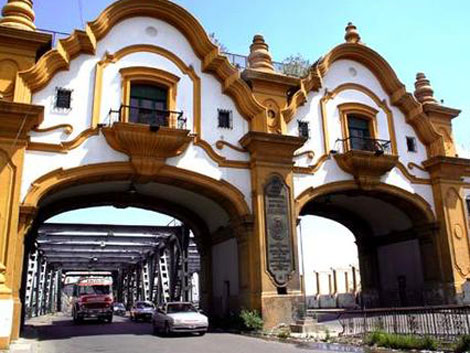
Nueva Pompeya is a barrio situated southwest of Microcentro that provides an important transitory link between Capital Federal and the south. Its southernmost border is split between Avenida 27 de Febrero and the Riachuelo river, after which are towns of Buenos Aires Province.
Would you want to visit Nueva Pompeya? Let’s take a few moments to find out.
An introduction to Nueva Pompeya
Much of the Nueva Pompeya barrio was built on a raised flood plain north of the Riachuelo. Being subject to regular flooding, it was sparsely populated and known for being an area of poverty and crime. Nevertheless, the area gained prominence for being one of the few places in the city where it was possible to cross the river thus provided a strategic gateway to the south. At the time it was possible to sail along the Riachuelo thus opened the door to contraband smuggling, a popular form of commerce during the Viceroy era.
The barrio takes its name from a church dedicated to the ‘Virgin del Rosario de Pompeya’ that was raised by Capuchin monks in 1900. Prior to this, it was locally known as ‘Barrio de la Ranas’ (District of Frogs). Frog means ‘wise man’ in Argentinean slang and it was supposed that local residents possessed cunning and intelligent attributes.
During the early 1900s, the vast majority of locals found employment at the slaughterhouses located in neighboring Parque Patricios. The barrio truly began to grow economically in the 1930s following the building of Puente Valentin Alsina, a bridge crossing the Riachuelo. This paved the way for industries to set up shop and the development of an urban district; it continues to be one of Buenos Aires’ most important industrial regions.
Today, Nueva Pompeya portrays a typical working class barrio and its residential zones are characterised by single storey terraced houses. It is also a barrio with a rich tango heritage, a characteristic that owes much to Homero Manzi who frequented the local bars and mentioned the barrio in his song ‘Mano Blanca’.
Things to see, do or both
The beating heart of Nueva Pompeya is Avenida Saenz, a boulevard traversing the centre of the barrio and connecting it with Boedo, to the north, and Valentin Alsina, to the south. Historically home to meat-packing plants, today the boulevard is dominated by factory outlets, cafés and other commercial activity. On a Sunday, head to the intersection with Avenida Perito Moreno where you will find La Feria de los Pajaros, a curios market selling all manner of colourful songbirds.
About five blocks west of the bird market you will arrive at Tabare street whose intersection with Avenida del Barco Centenera was the inspiration for Homero Manzi’s ‘Mano Blanca’. At the corner is Museo Mano Blanca, a museum paying homage to the barrio’s tango heritage. The building’s façade is adorned with murals and the lyrics to the museum’s namesake song.
It is doubtful that you’ll want to stray very far from Avenida Saenz when in Nueva Pompeya; however, Puente Valentin Alsina at the far south of the boulevard is worth a quick look. The colorful bridge displaying aspects of neoclassical and Hindu-revival style was inaugurated on November 26th 1938 to provide a link between the city and province. Actually renamed Puente Jose Felix Uriburu, most locals refer to it by its original name.
During the late 1800s and early 1900s, Nueva Pompeya was recognized for its collection of pulperias, bar-saloons frequented by local workers and members of the tango movement. Two particularly famous venues were Maria Adelia (Corrales and La Plata) and La Blanqueada (Saenz and Roca). Today, both are conserved as museums with memorabilia from the golden age of tango.
Nightlife and restaurants
Bar el Chino (Beazley 3566). An institution of Nueva Pompeya, Bar el Chino was opened by tango singer Jorge ‘Chino’ Garces and is widely believed to have been one of the birthplaces of tango in Buenos Aires. If you are brave enough to stick around the barrio after dark then the bar is arguably one of the best places in the city to experience a night of true porteño tango.
Kory Mega Disco (Saenz 459). It is unlikely that you’ll come to Nueva Pompeya for its nightlife but if you do then you might be interested in the mixed bag of events at Kory Mega Disco that range from milongas and tango shows to cumbia, reggaeton, salsa and folkloric concerts.
Why it’s hot / Why it’s not
Should you have a specific interest in tango then you might be tempted to visit Nueva Pompeya to check out the historical bars and Museo Mano Blanca. Also, if you are a fan of thrift store shopping, the Buenos Aires branch of the Salvation Army is situated at Avenida Saenz 580 where you could well find a bargain or collector’s item.
One the other hand, the constant noise of traffic ferrying people between La Provincia and Buenos Aires Centro is enough to put anyone off coming.
Finalmente
The Riachuelo river is widely recognized as being one of the most severely polluted rivers in the world, a consequence of contaminating products released from the factories of Parque Patricios. The river’s banks also house one of Buenos Aires’ most impoverished slums inhabited by Bolivians and people for Argentina’s northern rural regions who seek employment as unregistered manual laborers.

One Comment on ““Nueva Pompeya””
Pingback: New Buenos Aires Neighborhood Guides | A Gringo in Buenos Aires